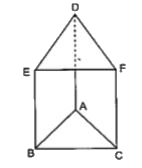The given figure shows a prism whose base is a shape of triangle. Let the vertices of the base triangle are A(1, 4, 2), B(-2, 1, 2) and C(2, -3, 4). Based on the above information answer the following questions.

The unit vector along the −−→BC is :
A
16(4ˆi−4ˆj+2ˆk)
B
16(4ˆi+2ˆk)
C
16(4ˆi−4ˆj)
D
None of these
Text Solution
The correct Answer is:A
|
Topper's Solved these Questions
- SAMPLE PAPER 01BOOK - ICSECHAPTER - SAMPLE PAPER 01EXERCISE - Questions (Section C)
8 Videos
- SAMPLE PAPER 01BOOK - ICSECHAPTER - SAMPLE PAPER 01EXERCISE - Questions (Section C)
8 Videos
- SAMPLE PAPER - 5 (MATHEMATICS)BOOK - ICSECHAPTER - SAMPLE PAPER - 5 (MATHEMATICS)EXERCISE - Questions (Section - C)
8 Videos
- SAMPLE PAPER 2 BOOK - ICSECHAPTER - SAMPLE PAPER 2 EXERCISE - QUESTIONS (SECTION - B)
16 Videos
Similar Questions
Knowledge Check
The area of the triangle whose vertices are A(1,2−1) B (3,1,4) and C (0,2,3)
A√1762sp unitB8 sq unitC√1862 sq unitDNone of theseThe area of the triangle whose vertices are A (1,2,3) B (2,−l,l) and C (l,2,−4) is
A7√10squnitsB12√10squnitsC72√10squnitsDNone of the theseThe co ordinates of the base BC of an isosceles triangle are B(1,3) and C(−2,7) then the co-ordinates of its vertex A are
A(56,6)B(−7,18)C(1,6)D(−12,5)
The vertices of a triangle ABC are are A(1,3,5),B(−2,4,7) and C(3,2,2). Then the direction cosines of the vector along bisector of ∠BAC is
View SolutionUsing vectors, find the area of the triangle whose vertices are:
A (3, ̶ 1, 2), B (1, ̶ 1, ̶ 3) and C ( 4, ̶ 3, 1)
View SolutionDraw the triangle whose vertices are (2,3),(−4,2)AND(3,−1)
View SolutionIf the area of a square with side a is equal to the area of a triangle with base a , then the altitude of the triangle is a2 (b) a (c) 2a (d) 4a
View SolutionIf the base angles of triangle are (2212)∘ and (11212)∘ , then prove that the altitude of the triangle is equal to 12 of its base.
View Solution
